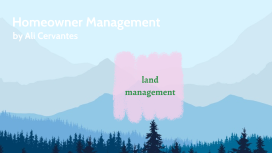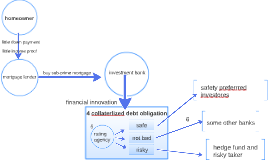homeowner management
Transcript: Homeowner Management by Ali Cervantes land management Open field Invasive species: hire help: listen to their best opinion. prairie grasslands: Pollinators: flower garden is good for bees to pollinate and look very nice next to prairie grass. Tall prairie grass has a large amount of carbon that is stored in plant roots and creates rich fertile soil. Owls enjoy tall grass often create their nest within it. Honeysuckle, lady ear drop, eastern blasting star are great pollinators. bees eat the nectar golden mouse eats the seeds and they live by vines. - shrubs: (called prairie grass) owls and mice both enjoy bushes. Open field Riparian zone and the oak savanna cord grass: tall grass is environmentally beneficial because its full of carbon and can help fish like bluegill hide in it. fallen trees: become shelter for fish inside river, especially bluegill. species: snails, crayfish, land and water invertebrates riverside in rivers and are all part of salamander and bluegills diet. mosquito are a hue issue by rivers so salamanders consume them and keep numbers down. Riparian Zone rocks: keep rock piles through stream or around for salamanders. give shade from sun. brush: brush piles purposely stacked piles of trees good for animals- salamanders enclosure. snag tree: dead trees that are left upright to decompose naturally turns into a log when they fall naturally. placed by creek can benefit salamanders outside of water and when it falls in water can also be beneficial. Altering the riparian water zone by adding cod grass, fallen trees, and brush piles all of this will provide new live and regenerate the river. to revive the oak savanna I'll use the guide to restore oak trees and remove any old woody vegetation. Flagship Species Flagship Blue spotted salamander: Aquatic biome: lakes and ponds, Land: moist woodlands, sandy soil. Summer: underground out of direct sun. Fall: damp forest under abandoned small mammal burrows, under rocks, logs. hibernate where they wont freeze. snails, small aquatic/ land invertebrates. The salamander breeds in woodland ponds and ditches Blue-spotted salamanders consume many mosquitoes each year. Short eared owl: open country, grasslands, marshes, fallow fields. small mammals, small birds, prefer meadow voles, nest on the ground sheltered by tall grass, reed or bushes. winter: they find more suborbital place to find prey in winter female will incubate eggs and tend to the next. once hatched the ale will bring food . generally roost on low perches on the ground. Bluegill: weed beds, shallow water with vegetation and fallen limbs and logs for protection. insects both aquatic and terrestrial. snails, small crayfish, other fish ad eggs. shelter in shallow waters in small ponds fish will often lay in dark mud bottoms in winter to create heat. female bluegill can release 2,300 to 81,100 eggs per spawn. bluegill can be beneficial they keep algae down in water. golden mouse: thick woodlands, swampy areas, among vines, and within small trees and shrubs, like to live where honey suckle grows Seeds, wild cherries, dogwood, and green brier They usually have underground nests but during the winter or floods they will relocate in the trees. Golden mice reproduce all year long. Ground nests, frequently located near leaf litter, may be fabricated within sunken areas of the soil or beneath logs Golden northern bumble bee: nest in grassy, open areas which include forest clearings and along roadsides found both above and below the ground, feed on the nectar of angiosperms and aid in the pollination of plants. winter: all members of hive die except queen . The young queens hibernate underground and emerges in spring ready to feed or build.she lays eggs in cells that she builds within the nest. 2.5 acres of aspen land Aspen forestry management Shelter wood: Best option for removing trees. part of the forest gets removed in several stage each stage = tree regeneration Choosing the best trees while they are relatively young, provide them with plenty of growing space by removing the weaker trees, and protect them from injury. On average or better sites, this will produce a forest of great value from every perspective. Forest require disturbance to regenerate Forest fires: stimulate new growth Insects: reduce aging trees and make forest more productive. Diseases: eliminate weak trees and give new species a chance to thrive Native trees importance: reduced noise and carbon pollution. Many native plants, especially long-living trees like oaks and maples, are effective at storing the greenhouse gas carbon dioxide. provide vital habitat for birds, many other species of wildlife benefits as well. piles/ fallen trees: used for other purposes through the sight. Honeysuckle: another great pollinator, aesthetically pleasing and golden mouse like to live in areas close to honey suckle. red cedar Homestead Living plans- live in home use major renovation and updates that are more environmentally friendly. starting a garden

















